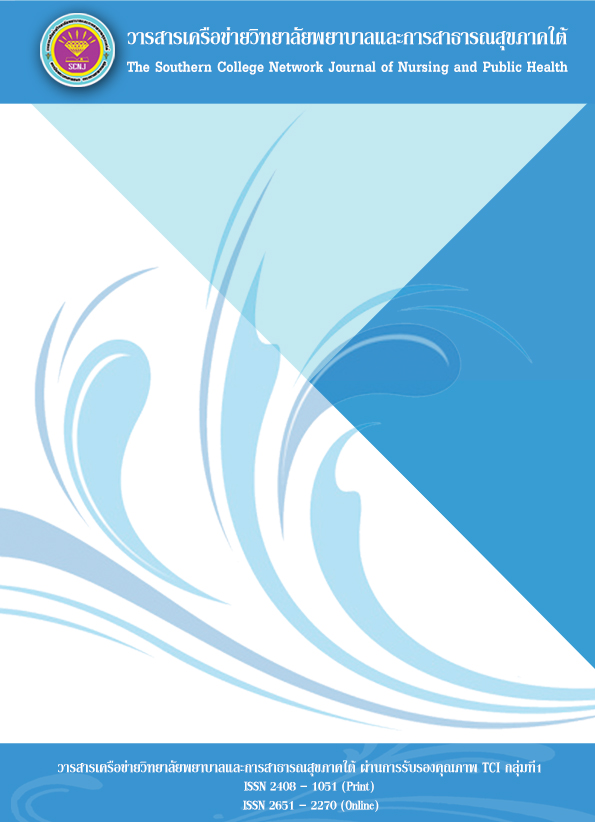รูปแบบการฟื้นฟูสภาพผู้สูงอายุพิการทางการเคลื่อนไหว ของอาสาสมัครสาธารณสุขประจำหมู่บ้าน
คำสำคัญ:
โปรแกรม, ผู้สูงอายุ, ผู้พิการทางการเคลื่อนไหวบทคัดย่อ
การวิจัยเชิงปฏิบัติการนี้มีวัตถุประสงค์เพื่อศึกษารูปแบบการฟื้นฟูสภาพผู้พิการทางการเคลื่อนไหวของอาสาสมัครสาธารณสุข กลุ่มตัวอย่างเลือกแบบเฉพาะเจาะจง ประกอบด้วย 1) สหสาขาวิชาชีพ ที่เกี่ยวข้องในการดูแลผู้สูงอายุ จำนวน 8 คน 2) ผู้สูงอายุที่มีความพิการทางการเคลื่อนไหวในพื้นที่แห่งหนึ่ง จำนวน 13 คน 3) อาสาสมัครสาธารณสุขที่ดูแลผู้สูงอายุพิการทางการเคลื่อนไหวและผู้ที่สนใจเข้าร่วมการวิจัย จำนวน 30 คน เครื่องมือวิจัย ประกอบด้วย แบบประเมินการปฏิบัติกิจวัตรประจำวันขั้นพื้นฐาน บาร์เทล เอดีแอล และแบบบันทึกพฤติกรรมการฟื้นฟูสภาพโดย อสม. ผ่านการตรวจหาความตรงด้านเนื้อหา ได้ค่า IOC ระหว่าง 0.67-1.00 ทุกข้อ โปรแกรมฟื้นฟูสภาพออกแบบโดยพยาบาลเวชปฏิบัติ และนักกายภาพบำบัด ผู้วิจัยนิเทศ อสม. โดยใช้ทักษะการสอนแนะทุกครั้งที่ทำการฟื้นฟูสภาพติดต่อกันเป็นเวลา 4 สัปดาห์ หลังจากนั้นนิเทศสัปดาห์ละ 1 ครั้ง จนครบ 6 เดือน วิเคราะห์ข้อมูลเชิงคุณภาพโดยการวิเคราะห์เนื้อหา ข้อมูลเชิงปริมาณวิเคราะห์โดยใช้สถิติความถี่ ร้อยละ และ Wilcoxon Matched – Pairs Signed Rank test ผลการวิจัยพบว่า
รูปแบบการฟื้นฟูสภาพผู้สูงอายุพิการทางการเคลื่อนไหวของ อสม. คือ 4Rs มี 4 ขั้นตอน คือ ขั้นที่ 1 ประเมินสถานการณ์ความต้องการฟื้นฟูสภาพผู้สูงอายุพิการทางการเคลื่อนไหว (Rehabilitation Need Assessment) ขั้นที่ 2 พัฒนาทักษะและกระบวนการฟื้นฟูสภาพผู้สูงอายุแก่ อสม. (Rehabilitation Skills and Process Development) ขั้นที่ 3 พัฒนากระบวนการฟื้นฟูสภาพผู้สูงอายุพิการทางการเคลื่อนไหวของ อสม. (Rehabilitation Process Improvement) และขั้นที่ 4 ขยายผลทักษะการฟื้นฟูสภาพผู้สูงอายุพิการทางการเคลื่อนไหวสู่ครอบครัว (Rehabilitation Skills Sharing) คะแนนทักษะการฟื้นฟูสภาพผู้สูงอายุพิการทางการเคลื่อนไหวของ อสม.สัปดาห์ที่ 4 ของโปรแกรมมากกว่าขณะสาธิตย้อนกลับอย่างมีนัยสำคัญทางสถิติ (p<.001) และคะแนนความสามารถปฏิบัติกิจวัตรประจำวันขั้นพื้นฐานของผู้สูงอายุหลังฟื้นฟูมากกว่าก่อนฟื้นฟูอย่างมีนัยสำคัญทางสถิติ (p<.001)
ผลการวิจัยนี้บุคลากรทางสุขภาพสามารถนำไปใช้ในการฟื้นฟูสภาพผู้สูงอายุพิการประเภทอื่นต่อไป
References
Ministry of Social Development and Human Security. (2016). Data Report Situation of the Disabled in Thailand. Retrieved August 15, 2017 from https://dep.go.th/sites/ default/files/ files/ news/Report_PWDS_SEP2559.pdf/.
Neurology Institute, Department of Medical Services, Ministry of Public Health. (2009). Guidelines for Promoting Safe Swallowing in Stroke Patients for Nurses. Retrieved August 25, 2017 from ttp://www.thaineuroinfo.com/th/wp-content/upload/ 2014/05/ SwallowingAssessment.pdf.
Onchuanjit, S., & Treethong R. (2006). Home Health Care Service. 2nded. Faculty of Nursing Prince of Songkla University. Songkla: Songkla University. (in Thai)
Prajanae, P. (2003). Frozen Shoulder Joint. Journal of Academic Service Center, 11(2), 11-14. (in Thai)
Petchroung, N., Priyatruk, P., & Thongkeang, V. (2013). The Study of Continuing Care for Patients with Cerebrovascular Disease in Primary Care Unit. Journal of the Royal Thai Army Nurses, 14(1), 25-34. (in Thai)
Phalasuek, R., Thanomchayathawatch, B. & Thonglert. D. (2017). A Community Participation Process in Teenage Pregnancy Prevention. The Southern College Network Journal of Nursing and Public Health, 4(2), 256-267. (in Thai)
Phromphat, C. (2013). Aging Society in Thailand: Retrieved August 15, 2017 from https://library.senate.go.th/document/Ext6078/6078440_0002.PDF.
Phothong, C., Deenan, A., & Sunsern, R. (2014) Effectiveness of Integrated Rehabilitation Model for Persons with Physical Disability in Community. Journal of the Royal Thai Army Nurses, 15(2), 232-241. (in Thai)
Sirindhorn Center for Rehabilitation of National Persons with Disabilities. (2008). Nursing Principles for Rehabilitation of the Disabled People: Documentation for the Rehabilitation Program. Nonthaburi: Ministry of Public Health. (in Thai)
Sorensen, S., Pinquart, M., & Duberstein, P. (2002). How Effective are Interventions with Caregivers? An Updated Meta-Analysis. Journal of Gerontology, 42(3), 356-72.
Sumangsri, S. (2015). Development of the Continuous Care Guidelines for the Home - Bound and Bed Bound Elders Living in the Vicinity of Family Practice Center. Journal of Phra Nakhon Si Ayutthaya Hospital, 5(1), 53-64. (in Thai)
Downloads
เผยแพร่แล้ว
ฉบับ
บท
License
1. บทความหรือข้อคิดเห็นใด ๆ ที่ปรากฏในวารสารเครือข่าย วิทยาลัยพยาบาลและการสาธารณสุขภาคใต้ ที่เป็นวรรณกรรมของผู้เขียน บรรณาธิการหรือเครือข่ายวิทยาลัยพยาบาลและวิทยาลัยการสาธารณสุขภาคใต้ ไม่จำเป็นต้องเห็นด้วย
2. บทความที่ได้รับการตีพิมพ์ถือเป็นลิขสิทธิ์ของ วารสารเครือข่ายวิทยาลัยพยาบาลและการสาธารณสุขภาคใต้







